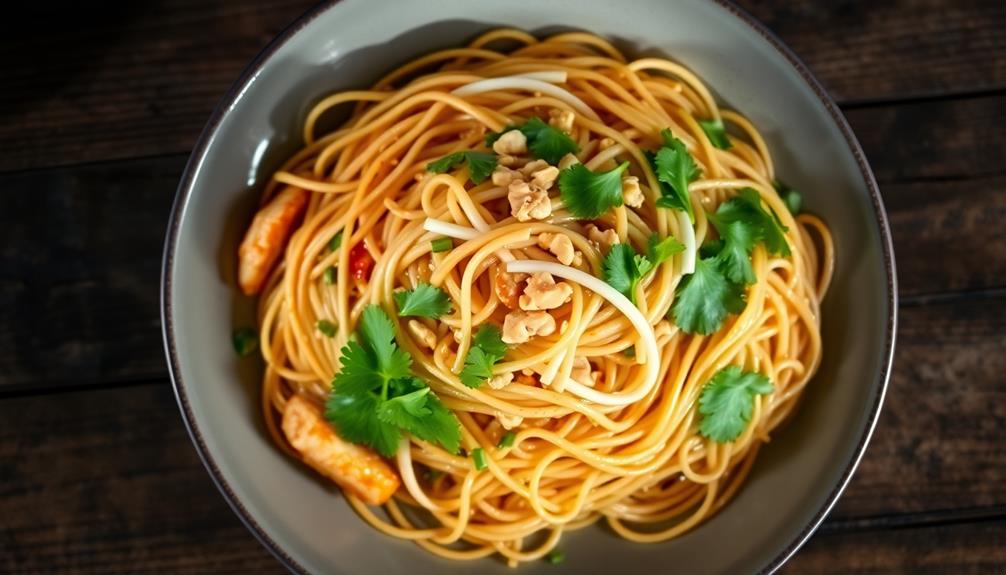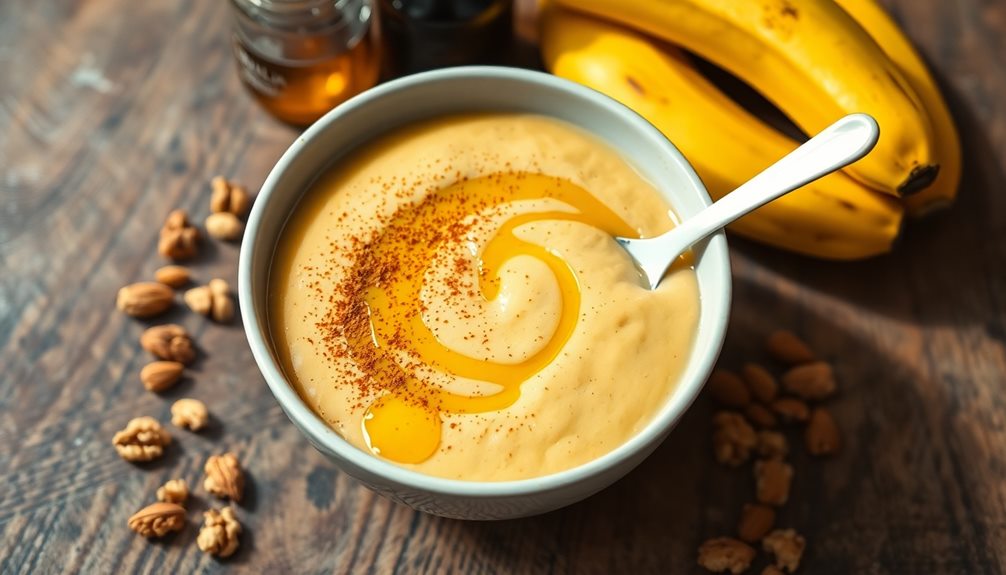Jerk chicken, Jamaica's iconic street food delight, will transport you to the vibrant markets of the island with its bold, fiery flavors. This beloved dish's origins trace back to the indigenous Taíno people, who used pimento wood and leaves for smoking meats. Later, African slaves contributed their spice blends, evolving the signature jerk seasoning that now features an irresistible balance of sweet, savory, and sizzling heat. Jerk chicken is a true cultural ambassador, showcasing Jamaica's resilience and creativity through its unique cooking methods and flavor profile. Take a culinary journey to the heart of Jamaican cuisine and discover why this dish is so revered.
Key Takeaways
- Jerk chicken is a beloved Jamaican dish with roots tracing back to the indigenous Taíno people and African slaves, showcasing the island's rich culinary heritage.
- The unique flavor profile of jerk chicken, featuring a blend of spices like allspice, thyme, and Scotch bonnet peppers, creates a zesty and bold taste experience.
- Traditional jerk cooking methods, such as using pimento wood and leaves for smoking, contribute to the dish's signature smoky char and enhance the overall flavor complexity.
- Jerk chicken is often enjoyed as a street food, with vendors serving it alongside sides like rice and peas or festival, creating a vibrant and communal dining experience.
- The enduring legacy of jerk chicken has led to its global popularity, as the dish continues to influence culinary trends and serve as a cultural ambassador for Jamaican cuisine.
History
Originating in the hills of Jamaica, jerk chicken's history can be traced back to the island's indigenous Taíno people. These early inhabitants used pimento wood and leaves to slowly smoke and season meats, creating a bold, spicy flavor.
Over time, the technique evolved as African slaves brought their own spices and cooking methods to the island. The name "jerk" likely comes from the Quechua word "charqui," meaning dried, salted meat.
As Jamaican cuisine grew, jerk chicken became a beloved staple, often sold by street vendors. The spicy, aromatic dish quickly gained popularity, and today it's considered a national treasure.
From humble beginnings to global fame, jerk chicken's history is a flavorful tale of Jamaica's rich culinary traditions. Whether savored on the streets or in your own kitchen, this fiery delight captures the spirit of the island.
Recipe
Jerk chicken is a beloved dish that originates from the vibrant streets of Jamaica. The term "jerk" refers to the unique spice blend that imbues the meat with a captivating blend of sweet, savory, and fiery flavors. This recipe captures the essence of authentic Jamaican jerk chicken, perfect for bringing a taste of the islands to your own kitchen.
The key to exceptional jerk chicken lies in the marinade. A combination of aromatic spices, herbs, and a touch of sweetness creates a flavor profile that's truly addictive. The chicken is then slow-cooked, allowing the spices to permeate the meat, resulting in a tender, juicy, and intensely flavored dish.
Ingredients:
- 2 lbs chicken thighs or drumsticks
- 2 tablespoons jerk seasoning
- 1 onion, diced
- 3 cloves garlic, minced
- 1 scotch bonnet or habanero pepper, seeded and diced
- 1 tablespoon brown sugar
- 2 tablespoons soy sauce
- 1 tablespoon lime juice
- 1 teaspoon thyme
- Salt and black pepper to taste
Instructions:
In a large bowl, combine the jerk seasoning, onion, garlic, scotch bonnet pepper, brown sugar, soy sauce, lime juice, and thyme. Add the chicken and toss to coat evenly. Cover and marinate in the refrigerator for at least 30 minutes, or up to 24 hours for maximum flavor.
Preheat your grill or oven to 375°F (190°C). If grilling, arrange the chicken on the grates and cook for 20-25 minutes per side, or until the internal temperature reaches 165°F (75°C). If baking, place the chicken in a baking dish and roast for 35-40 minutes, turning halfway, until fully cooked.
When cooking jerk chicken, it's crucial to keep a close eye on the heat level. The scotch bonnet or habanero pepper adds a fiery kick, so adjust the amount to suit your spice tolerance.
Serve the jerk chicken with your choice of sides, such as rice and peas, plantains, or a refreshing Caribbean slaw, to balance the heat and complete the authentic Jamaican experience.
Cooking Steps
First, you'll want to marinate the chicken in a blend of spices overnight.
Then, grill the chicken over pimento wood to get that authentic Jamaican flavor.
Don't forget to baste the chicken with pimento oil as it cooks.
Serve the jerk chicken with a side of fragrant rice and peas, and garnish with freshly chopped scallions for a vibrant finishing touch.
Step 1. Marinate Chicken in Spices Overnight
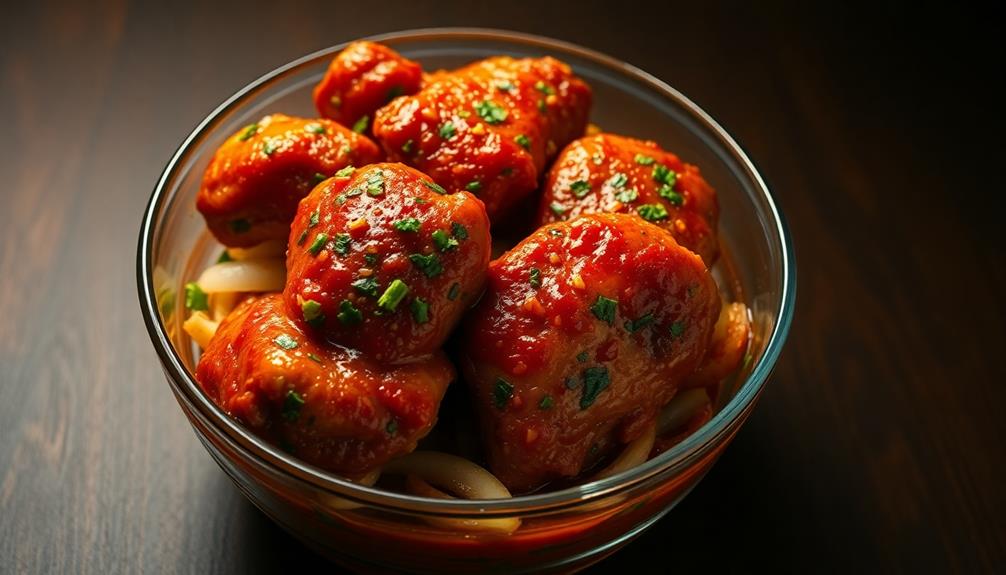
After you've gathered all the necessary ingredients, it's time to prepare the jerk marinade. In a large bowl, combine the allspice, thyme, garlic, brown sugar, and a generous pinch of salt. Give it a good stir to blend the flavors.
Next, add the soy sauce, lime juice, and a few tablespoons of water. Whisk everything together until the marinade is smooth and well-incorporated.
Now it's time for the star of the show – the chicken! Place the chicken pieces in the bowl and use your hands to massage the marinade all over the meat. Make sure every nook and cranny is coated.
Once the chicken is fully covered, cover the bowl with plastic wrap and pop it in the fridge. Let the chicken marinate for at least 8 hours, or even better, overnight. This allows the flavors to really sink in and infuse the chicken with that signature Jamaican jerk taste.
Step 2. Grill Chicken Over Pimento Wood

Once the chicken has marinated to perfection, it's time to bring that authentic Jamaican flavor to life on the grill. You'll need some pimento wood, which is also known as allspice wood. This wood is the secret ingredient that gives jerk chicken its signature smoky aroma and taste.
Carefully place the marinated chicken pieces directly over the pimento wood coals, allowing the smoke to infuse the meat.
Keep a close eye on the chicken, turning it occasionally to ensure even cooking. The high heat will create a beautiful char on the outside, locking in all those delicious juices. As the chicken sizzles, the pimento wood smoke will waft through the air, filling your senses with the tantalizing scents of the islands.
Once the chicken is cooked through, with an internal temperature of 165°F, remove it from the grill. Get ready to savor the bold, spicy, and smoky flavors that define authentic Jamaican jerk chicken.
Step 3. Baste Chicken With Pimento Oil
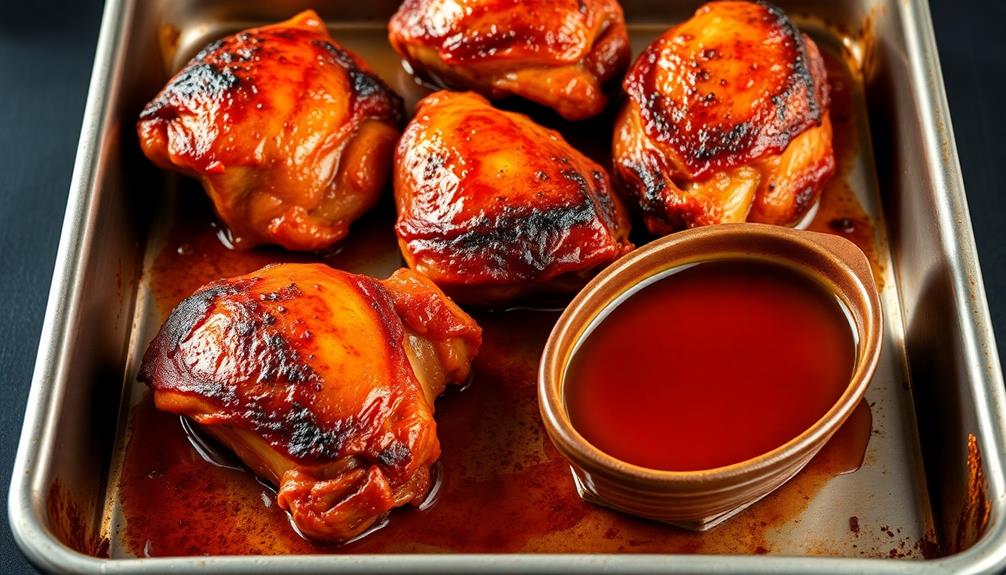
As the chicken sizzles over the pimento wood coals, baste it generously with pimento oil. The warm, aromatic oil will soak into the meat, infusing it with the unique flavor of Jamaica's famous allspice.
Dip a brush into the oil and sweep it across the chicken's skin, ensuring every inch is coated. Watch as the oil glistens on the surface, creating a shiny, golden-brown crust.
Don't be shy with the basting – keep reapplying the oil throughout the cooking process. The more you baste, the more intense the pimento flavor will be. The oil's heat will also help caramelize the chicken, adding a delightful crunch to the outside while keeping the interior juicy and tender.
Be mindful not to over-baste, as too much oil can lead to flare-ups. A light, even coating is all you need to achieve the perfect jerk chicken.
With each brushstroke, you're bringing the vibrant tastes of Jamaica right to your plate.
Step 4. Serve Chicken With Rice and Peas
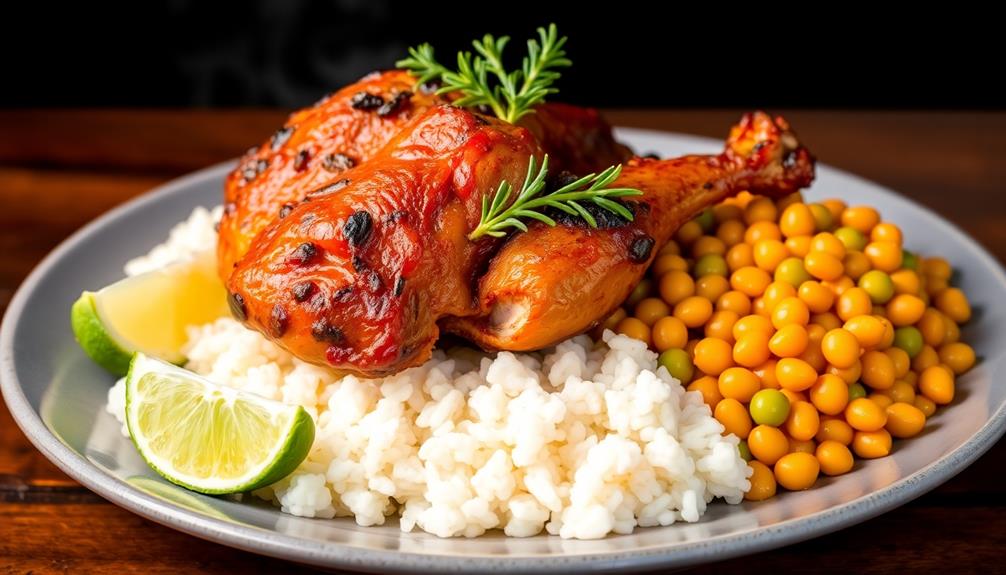
With the jerk chicken perfectly grilled and basted, it's time to round out the meal with a classic Jamaican accompaniment – rice and peas. This simple yet satisfying side dish is the perfect complement to the bold, spicy flavors of the chicken.
First, you'll need to cook the rice. Follow the package instructions, adding in the peas towards the end of the cooking time. The peas will become tender and infuse the rice with their earthy sweetness.
Be sure to fluff the rice with a fork when it's done, allowing the grains to separate and create a light, fluffy texture.
Now, it's time to serve. Scoop the fragrant rice and peas onto a plate, then top it with a generous portion of the juicy, seasoned jerk chicken.
The contrast of the tender meat, the fluffy rice, and the pop of the peas creates a harmonious blend of flavors and textures that will have your taste buds dancing. Savor every bite and let the bold Jamaican flavors transport you to the vibrant streets of the island.
Step 5. Garnish With Chopped Scallions
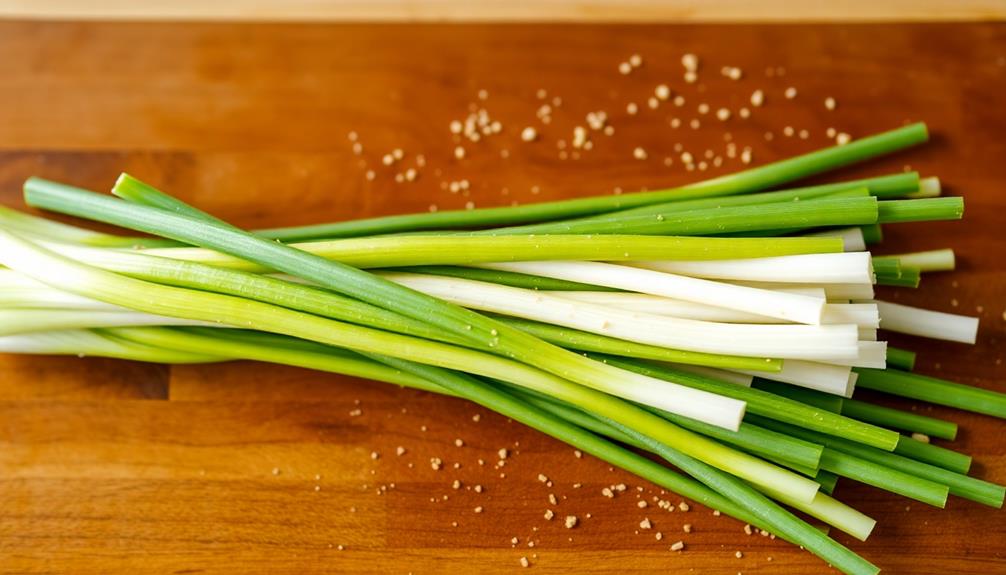
Finally, give the dish an extra pop of color and freshness by sprinkling chopped scallions over the top.
These green onions add a delightful crunch and a hint of onion flavor that perfectly complements the bold, spicy jerk seasoning. Be generous with the scallions, allowing them to cover the chicken in a vibrant green garnish.
The contrast of the soft, tender chicken and the crisp, fresh scallions creates a delightful texture and flavor combination. Plus, the scallions add a beautiful visual appeal, making the dish look even more appetizing.
Don't be shy – pile on those scallions! Their bright, zesty taste will liven up every bite, adding a refreshing touch to balance the heat of the jerk seasoning.
With the scallions in place, your authentic Jamaican jerk chicken is ready to be savored and enjoyed to the fullest.
Final Thoughts
Jerk chicken's enduring popularity is a testament to its irresistible flavor profile and the cultural significance it holds in Jamaica's vibrant food landscape.
As you've discovered, the unique blend of spices, the slow-cooking method, and the smoky char create a truly unforgettable dining experience. Whether you've savored it straight from a roadside stall or recreated it in your own kitchen, jerk chicken's ability to transport you to the heart of Jamaican culture is undeniable.
As you bid farewell to this delectable journey, remember that the essence of jerk chicken extends far beyond the plate. It's a reflection of the island's resilience, creativity, and deep-rooted culinary traditions.
The next time you indulge in a flavorful bite, let it be a reminder of the vibrant spirit and rich history that make Jamaica such a captivating destination. Embrace the fiery flavors, the lively atmosphere, and the endless possibilities that jerk chicken holds for culinary exploration.
Frequently Asked Questions
What Are the Health Benefits of Eating Jerk Chicken?
Eating jerk chicken can provide you with a healthy dose of protein, which is essential for building and repairing tissues in your body. The spices used in the marinade may also offer anti-inflammatory benefits and boost your metabolism.
How Long Can Jerk Chicken Be Stored After Cooking?
After cooking, jerk chicken can be stored for up to 4 days in the refrigerator or 3 months in the freezer. Make sure to let it cool completely before storing and reheat thoroughly before serving.
Can Jerk Chicken Be Made in a Slow Cooker?
You can absolutely make jerk chicken in a slow cooker. The slow cooking method helps the flavors meld and tenderizes the meat, resulting in a delicious and authentic Jamaican-style dish you can enjoy at home.
What Are the Best Side Dishes to Serve With Jerk Chicken?
When serving jerk chicken, you'll want to pair it with tasty side dishes that complement the bold, spicy flavors. Consider sides like rice and peas, roasted sweet potatoes, coleslaw, and plantains to balance out the heat of the jerk seasoning.
How Spicy Is Authentic Jerk Chicken Compared to Other Cuisines?
Authentic jerk chicken is quite spicy, even more so than many other cuisines. You'll likely find it to be hotter than typical Mexican or Indian dishes, with a bold, complex blend of spices that pack a punch.






